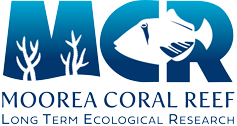Year:
2021
Authors:
Source:
M.S. Thesis
Abstract:
Within the past decade, a functional group of encrusting red macroalgae defined as peyssonnelid algal crusts (PAC) has been rapidly spreading on shallow Caribbean reefs, frequently encrusting corals and sponges. By accentuating decadal-scale trends in favor of macroalgae on coral reefs, and acting to make a phase reversal very difficult, PAC may be functioning as an ecological catalyst. To explore this theory, I investigated potential mechanisms for favoring success of PAC on present day reefs. In St. John, I expanded the monitoring of PAC abundance at two sites and tested two mechanisms, rapid linear growth and competitive dominance, by which PAC is hypothesized to enhance its capacity to spread. The cover of PAC at these two sites in 2019 was identical to, or up to 2.4-fold higher than in August 2017, and 2.1–3.7-fold higher than in November 2017, just after two category 5 storms impacted St. John. PAC was 1.8–29.1-fold more abundant at 3 m versus 9 m depth, and 1.4–22.0-fold more abundant at sites close to the tips of headlands than sites sheltered within bays. From August 2019 to January 2020, the rate of linear extension of PAC at each site and depth ranged from 26–43 µm d-1, and of 80 PAC-coral interactions that were tagged in August 2019, none involved corals that had become completely overgrown by PAC by January 2020. In Moorea, I aimed to investigate whether PAC was modulating the physiology of juvenile corals and coral larval settlement in order to spread on shallow reefs. While proximity to PAC did not affect juvenile coral growth rates, 24 hours of direct contact with PAC resulted in a mean effective quantum yield indicative of corals under stress. However, after 6 days of direct contact, corals in both treatment and control groups had high maximum photochemical efficiencies. At the larval stage, the presence of PAC increased Pocillopora acuta mortality. Together, these results support an emerging picture of the spatial growth and abundance of PAC, while dismissing three of the most compelling hypotheses to explain the rapid spread of PAC on Caribbean reefs. The slow linear growth and absence of definitive cases where PAC inhibited both juvenile and adult corals are inconsistent with the rate at which PAC returned to pre-hurricane cover. One means to reconcile these observations is the possibility that recruitment of peyssonnelid spores to benthic surfaces facilitates the rapid spread of PAC.
Publication Type:
Thesis or Dissertation
Publisher:
Department of Biology, CSU Northridge



